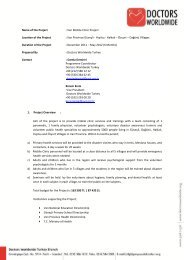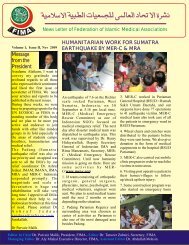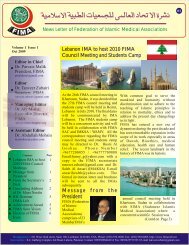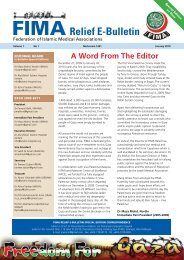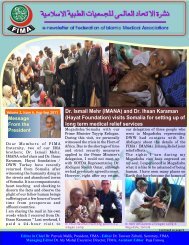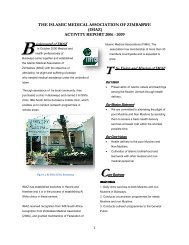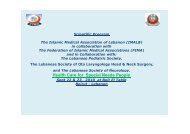FIMA Year Book 2010-2011 - Federation of Islamic Medical ...
FIMA Year Book 2010-2011 - Federation of Islamic Medical ...
FIMA Year Book 2010-2011 - Federation of Islamic Medical ...
You also want an ePaper? Increase the reach of your titles
YUMPU automatically turns print PDFs into web optimized ePapers that Google loves.
SAVE VISION<br />
In 2004, according to the World Health<br />
Organization (WHO), approximately 314 million<br />
people worldwide have low vision, and out <strong>of</strong><br />
those, 44 million people are blind. Eighty percent<br />
<strong>of</strong> blindness is avoidable, i.e. treatable and/or<br />
preventable 1 .<br />
In <strong>2010</strong>, WHO released latest global estimates <strong>of</strong><br />
visual impairments. Number <strong>of</strong> people with visual<br />
impairment, worldwide, is 285 million. Of those,<br />
39 million are blind 3 .<br />
The improvement in numbers has been attributed<br />
largely to decline <strong>of</strong> infectious causes.<br />
The top three causes <strong>of</strong> visual impairment in 2004<br />
were: Uncorrected refractive errors, cataract and<br />
glaucoma.<br />
The top three cause <strong>of</strong> blindness in <strong>2010</strong>, were:<br />
Cataract, glaucoma, and age-related macular<br />
degeneration.<br />
For every 24 hours, 86,400 individuals are added<br />
to the blindness pool, 50,000 <strong>of</strong> them are due to<br />
cataract, out <strong>of</strong> whom only 30,000 are operated<br />
upon, and around 20,000 are added to the backlog<br />
<strong>of</strong> cataract 3-5 .<br />
Cataract blindness can be treated successfully with<br />
surgery. Cataract surgery is considered one <strong>of</strong> the<br />
most cost-effective forms <strong>of</strong> health interventions 2 .<br />
In some developing countries, the rate <strong>of</strong> cataract<br />
surgery is less than 250 operations per million<br />
people per year, as compared to a rate <strong>of</strong> 8,000 in<br />
some developed countries.<br />
One million people are operated upon every year,<br />
but 1.5 million are added every year 3-5 .<br />
WHO estimates that without major intervention,<br />
the number <strong>of</strong> blind people will escalate to 75<br />
million in 2020 2 , and the economic burden <strong>of</strong><br />
blindness will rise from USD 42 billion per annum<br />
in 2000 to 111 billion by the year 2020 2 .<br />
In the Eastern Mediterranean region, WHO<br />
statistics reveal widespread prevalence <strong>of</strong> visual<br />
impairments, with at least 6 million people with<br />
various degrees <strong>of</strong> visual impairment.<br />
Seven countries in the region have extensive needs<br />
for combating various etiologies <strong>of</strong> blindness,<br />
namely: Somalia, Sudan, Djibouti, Yemen, Iraq,<br />
Palestine and Afghanistan 6 .<br />
In Sudan, as an example, there were 160<br />
ophthalmologists by 2003, <strong>of</strong> whom 110 were in<br />
the capital area, Khartoum. Only 50 were scarcely<br />
dispersed in the remaining provinces <strong>of</strong> Sudan. In<br />
the province <strong>of</strong> West Darfur, there was not a<br />
single eye doctor, or eye-care facility until late<br />
2005 7,8 .<br />
In this paper, we will present the <strong>FIMA</strong> Save<br />
Vision Program launched in January 2005, starting<br />
in Darfur-Sudan, following a pilot visit by a<br />
medical relief team from Jordan, led by then<br />
<strong>FIMA</strong> president Dr. Aly Misha’l, in October 2004.<br />
<strong>FIMA</strong> leadership has adopted this relief program<br />
as an ongoing activity, wherever needed to<br />
alleviate human suffering. A steering committee<br />
was appointed with headquarters in Pakistan,<br />
where experienced and dedicated<br />
ophthalmologists have established a record <strong>of</strong><br />
excellence in combating visual impairment in<br />
South Asia.<br />
Cataract, as a leading cause <strong>of</strong> blindness around<br />
the globe, holds true for Sudan as well. It is<br />
estimated that cataract represents approximately<br />
60% out <strong>of</strong> all etiologies <strong>of</strong> blindness there. The<br />
backlog <strong>of</strong> cataract cases in the country is<br />
estimated to be around 350,000 7,8 .<br />
Cataract surgical rate (CSR) in Sudan was only<br />
830, and Sudanese health authorities aim to<br />
achieve a CSR <strong>of</strong> 2500 by the year <strong>2010</strong>. This<br />
target, though not that high, might be quite<br />
difficult to achieve, given the various constraints<br />
Sudan is facing.<br />
Program objectives:<br />
1- Reach out to people suffering from visual<br />
impairment in needy, deprived communities,<br />
especially in remote areas in Africa and Asia.<br />
The main target is alleviation <strong>of</strong> cataract, the<br />
main cause <strong>of</strong> treatable blindness.<br />
2- Training and capacity building <strong>of</strong> local eye<br />
doctors, nurses and other paramedics, in an<br />
effort to maintain and widen the SAVE<br />
VISION Program by qualified local expertise.<br />
3- Establishment <strong>of</strong> permanent, fairly wellequipped<br />
and sustainable eye hospitals, or eye<br />
<strong>FIMA</strong> <strong>Year</strong><strong>Book</strong> <strong>2010</strong>-<strong>2011</strong> 54




